
A Head to Head Comparison of the Latest Gaming Consoles
January 22, 2024Choosing the right gaming console can be tricky. Each offers its own strengths and weaknesses. Pricing is important, as is the game library. Luckily, both Sony and Microsoft have robust libraries of popular cross-platform games.
The Xbox Series X is the most powerful of the new consoles, with SSD for super-fast loading times and specs that pitch it just above PS5 – it’s basically a high-end gaming PC in a box.
PlayStation 5
Two years into the current console cycle, Sony’s PlayStation 5 remains one of the most compelling options for those looking to upgrade from their old PS4. The PlayStation is a powerful system that delivers next-generation gaming, thanks to a cutting-edge SSD and GPU that enable 4K at 120fps and ray-tracing on select games. It also supports high refresh rates on compatible TVs, which reduces screen tearing and makes games feel smoother.
But its gargantuan size might not be for everyone, and it lacks backwards compatibility with Xbox 360 and OG Xbox titles (though some of them work on the higher-powered Xbox Series X). Still, its impressive hardware and roster of great first-party games makes it an excellent choice for anyone wanting to take advantage of what’s new in gaming.
Xbox One X
Microsoft’s Xbox One X boasts the most powerful hardware currently available in a console. It can output games at native 4K resolution and is optimised for televisions capable of high dynamic range (HDR).
It can also upscale games to look better on non-4K TVs. If your TV supports Freesync, the One X can use AMD’s technology to sync the monitor’s refresh rate with the game’s framerate, removing screen tearing and input lag.
The console is also sleek and quiet, with the power supply now housed in the rear of the unit versus the top. The design also allows it to be stacked horizontally with other electronic devices without worrying about overheating issues. However, it still suffers from a lack of exclusive titles compared to Sony’s PlayStation lineup.
Nintendo Switch
Nintendo Switch is an insanely popular console that has a unique hybrid design. You can use it as a portable console connected to your TV or as a handheld with detachable Joy-Con controllers.
Its newest model has a more advanced OLED display that is more vibrant with deep blacks than its LCD predecessors. It also supports Bluetooth audio devices like headsets and speakers.
The main downside of the Switch is that it lacks a lot of major, multi-platform games. It also suffers from a cycle where not enough people buy the console, so developers don’t create as many games for it. This isn’t quite as big of a problem as it would be with the PlayStation 5 or Xbox Series X. However, it’s still a concern.
Steam Deck
Last February, Valve took a risk with a new handheld device called the Steam Deck that shoehorned laptop-grade PC components into a portable handheld. While it didn’t have the sharpest screen or quickest processing, its combination of a powerful GPU-based chip and a Windows-compatible operating system made it an exciting alternative to consoles and even more expensive gaming tablets.
The Deck’s ARM-based CPU uses an AMD Zen 2 design that’s cut down for the device and performs closer to the power of PlayStation 5 and Xbox One X than the full version used in laptops. Its GPU also uses an AMD Radeon RDNA 2 architecture, which gives the Deck smooth graphics performance in moderately intensive games with decent battery life.
The only real drawback to the Deck is a lack of software flexibility. It runs a customized version of Linux, which means that not every Windows game will run.
ASUS Rog Ally
The ROG Ally is a handheld gaming PC that runs Windows 11. This is a strength and a weakness for the device. Most games work out of the box and the touch controls are responsive, but apps like Microsoft’s desktop launcher and Google’s Chrome browser feel sluggish and unintuitive.
Asus kept the design simple and straightforward, with a white finish and RGB lighting under the two analog sticks. It feels comfortable to hold and the design is less gimmicky than Valve’s Steam Deck.
The Ally’s display is one of its biggest selling points, with a 120Hz resolution screen that’s more colorful and brighter than the Steam Deck’s 800p panel. It’s also more accurate in terms of color reproduction, which is a big plus for those who prefer a more natural look.




